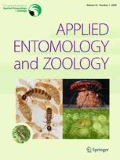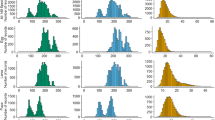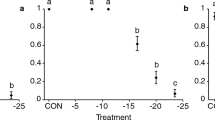Abstract
The development, reproduction, and population growth of Thrips nigropilosus Uzel (Thysanoptera: Thripidae), reared on leaves of Chrysanthemum morifolium Ramat (Asteraceae), were studied at seven different constant temperatures. Temperature and development rate of T. nigropilosus from egg to adult were linearly related between 15 and 25 °C, allowing the calculation of a lower threshold of 9.26 °C and a thermal constant of 238.1 degree-days. At 35 °C, eggs failed to hatch and larvae did not develop into adults. Adult longevity decreased with increasing temperature between 15 and 35 °C and females lived longer than males. Mean fecundity was highest at 30 °C, with 42.4 eggs per female. The intrinsic rate of natural increase was highest at 30 °C 0.173. During the late summer to spring, which is the main cultivation season for chrysanthemum in Okinawa, a maximum of 11 generations of T. nigropilosus could occur according to our calculations based on meteorological data from 2015 to 2016.

Similar content being viewed by others
References
Anyango JJ (1992) The life history of chrysanthemum thrips, Thrips nigropilosus Uzel (Thripidae: Thysanoptera) and an evaluation of the effects of temperature on its life cycle. Int J Trop Insect Sci 13:41–44
Birch LC (1948) The intrinsic rate of natural increase of an insect population. J Anim Ecol 17:15–26
Bullock JA (1965) The assessment of population of Thrips nigropilosus Uzel. on pyrethrum. Ann Appl Biol 55:1–12
Ganaha-Kikumura T, Ohno S, Kijima K, Masumoto M, Maekado N (2012) Species composition of thrips (Thysanoptera: Thripidae) and spider mites (Acari: Tetranychidae) on cultivated chrysanthemum (Asteraceae) in Okinawa, southwestern Japan. Entomol Sci 15:232–237
Ganaha-Kikumura T, Kijima K, Ohno S (2014) Effects of several commercial pesticides on the survival of Thrips nigropilosus (Thysanoptera: Thripidae) infesting chrysanthemum in Okinawa prefecture. Jpn J Appl Entomol Zool 58:275–279 (in Japanese with English abstract)
Gay L, Eady PE, Vasudev R, Hosken DJ, Tregenza T (2009) Costly sexual harassment in beetle. Physiol Entomol 34:86–92
Helinski MEH, Harrington LC (2012) The role of male harassment on female fitness for the dengue vector mosquito Aedes aegypti. Behav Ecol Sociobiol 66:1131–1140
Hodek I, Honěk A (1996) Ecology of Coccinellidae. Kluwer, Dordrechit, p 464
Japan Meteorological Agency (2011) Normal value derived from the weather data from 1981–2010 in Naha. http://www.data.jma.go.jp/obd/stats/etrn/view/nml_sfc_ym.php?prec_no=91&block_no=47936&year=&month=&day=&view=p1. (in Japanese) Accessed 14 March 2016
Katayama H (1997) Effect of temperature on development and oviposition of western flower thrips Frankliniella occidentalis (Pergande). Jpn J Appl Entomol Zool 41:225–231 (in Japanese with English abstract)
Kawai A (1986) Studies on population ecology and management of Thrips palmi Karny. Bull Veg Ornam Crops Res Stn Jpn Ser C 9:69–135 (in Japanese with English summary)
Kiritani K (2012) The low development threshold temperature and the thermal constant in insects and mites in Japan (2nd edition). Bull Nat Ins Agro Environ Sci No 31:1–74 (in Japanese with English summary)
Li XW, Jiang HX, Zhang XC, Shelton AM, Feng JN (2014) Post-mating interactions and their effects on fitness of female and male Echinothrips americanus (Thysanoptera: Thripidae), a new insect pest in China. PLoS One 9:e87725
Li XW, Fail J, Shelton AM (2015) Female multiple matings and male harassment and their effects on fitness of arrhenotokous Thrips tabaci (Thysanoptera: Thripidae). Behav Ecol Sociobiol 69:1585–1595
Mound LA (2010) Species of the genus Thrips (Thysanoptera, Thripidae) from the afro-tropical region. Zootaxa 2423:1–24
Mound LA, Morison GD, Pitkin BR, Palmer JM (1976) Thysanoptera: handbooks for the identification of British insects part 11, vol 1. Royal Entomological Society, London, p 79
Murai T (1988) Studies on the ecology and control of flower thrips Frankliniella intonsa (Trybom). Bull Shimane Agric Expt Stn 23:1–73
Murai T (2000) Effect of temperature on development and reproduction of the onion thrips, Thrips tabaci Lindeman (Thysanoptera: Thripidae), on pollen and honey solution. Appl Entomol Zool 35:499–504
Murai T (2001) Development and reproductive capacity of Thrips hawaiiensis (Thysanoptera: Thripidae) and its potential as a major pest. Bull Entomol Res 91:193–198
Nagamine Y (1994) Notes on the important pest species on chrysanthemum and orchid and their control in Okinawa Prefecture. Noko Engei 49:129–131 (in Japanese)
Nakao S (1993) Effects of temperature and photoperiod on wing form determination and reproduction of Thrips nigropilosus Uzel (Thysanoptera: Thripidae). Appl Entomol Zool 28:463–472
Nakao S (1994) Effects of food type on wing form determination and development in female Thrips nigropilosus Uzel (Thysanoptera: Thripidae). Appl Entomol Zool 29:273–278
Nakao S (2004) Evolutionary ecology of wing polymorphism in Thysanoptera. In: Fujisaki K, Tanaka S (eds) Flight and phase polymorphism of insects. Tokai University Press, Kanagawa, pp 121–137 (in Japanese)
Nakao S (2011) Geographical variation of photoperiodic wing form determination and genetic background of reproductive diapause in arrhenotokous populations of Thrips nigropilosus Uzel (Thysanoptera: Thripidae) in Japan. Appl Entomol Zool 46:111–116
Nakao S, Yabu S (1998) Ethological and chemical discrimination between thelytokous and arrehenotokokus Thrips nigropilosus Uzel, with discussion of taxonomy. Jpn J Appl Entomol Zool 42:77–83 (in Japanese with English abstract)
Nonaka K, Teramoto S, Nagai K (1982) Ecology and control of thrips infesting fruit vegetables. 5. Developmental velocity of Thrips palmi. Proc Assoc Pl Prot Kyushu 28:126–127 (in Japanese)
Rossi BH, Nonacs P, Pitts-Singer TL (2010) Sexual harassment by males reduces female fecundity in the alfalfa leafcutting bee, Megachile rotundata. Anim Behav 79:165–171
Sakimura K (1939) On the host plants of some Hawaiian thrips. Proc Hawaii Entomol Soc 10:251–254
Stannard LJ (1968) The thrips, or Thysanoptera, of Illinois. Ill Nat Hist Surv Bull 29:213–552
Tatara A (1994) Effect of temperature and host plant on the development, fertility and longevity of Scirtothrips dorsalis Hood (Thysanoptera: Thripidae). Appl Entomol Zool 29:31–37
The Ministry of Agriculture, Forestry and Fisheries of Japan (2013) Amount and composition of principal agricultural products in Japan. Analytical Indicator 4-1. http://www.e-stat.go.jp/SG1/estat/List.do?lid=000001129518. (in Japanese) Accessed on 14 March 2016
Umeya K, Okada T (eds.) (2003) Agricultural insect pests in Japan. Zenkoku Nôson Kyôiku Kyôkai, Tokyo, p 1203 (in Japanese)
Acknowledgments
We wish to thank Dr N. Arakaki (Okinawa Prefectural Agricultural Research Center) for his comments on an early draft of the manuscript. We would like to express our gratitude to Mr S. Yoshitake, Ms S. Kinjyo, Ms K. Gibu, and Mr N. Moriguchi (Okinawa Prefectural Agricultural Research Center) for helping with our investigations. Thanks are also due to Mr D. Yamaguchi (Kyushu University) for providing us with information on previous studies.
Author information
Authors and Affiliations
Corresponding author
Rights and permissions
About this article
Cite this article
Ganaha-Kikumura, T., Kijima, K. Effects of temperature on the development and fecundity of Thrips nigropilosus (Thysanoptera: Thripidae) on Chrysanthemum morifolium (Asterales: Asteraceae). Appl Entomol Zool 51, 623–629 (2016). https://doi.org/10.1007/s13355-016-0439-y
Received:
Accepted:
Published:
Issue Date:
DOI: https://doi.org/10.1007/s13355-016-0439-y




